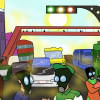A rudimentary approach to controlling traffic

Using manual traffic signals instead of automated traffic lights and other technological methods has become the norm in Dhaka city. For example, recent years saw the trend of traffic police using laser lights in various intersections of the city. If these lights come into contact with one's eyes, one can be unable to see properly for minutes. Experts say, exposure to such lights can lead to cataracts and even blindness. And when they fall on the eyes of drivers, it increases the possibility of accidents, as a report by this daily suggests.
Even the traffic sergeants at various points in Dhaka have admitted that using such lights is harmful, but they still use it because they have to control traffic from afar at times, and raising their voices does not help amid all the commotion around. However, this is no excuse for using such a harmful method. The law enforcement which should be deterring the use of such lights by the public cannot be using them themselves. This means that existing means of enforcement are not working or that we do not know how to use them. Reportedly, the traffic department is discouraging the use of these lights, to little effect so far. They also say that they confiscate the lights when they come across them and forbid their staff to use them.
We must ask, whose idea was it in the first place to use these laser lights? Why have we taken such a rudimentary approach to traffic control when the country is dreaming to be a Smart Bangladesh? We must look for modern ways of managing traffic that are also practical. If not grounded in reality, even solutions like the modern-sounding AI-driven traffic control system will fail, according to experts. For that to work, we must first establish discipline on our roads. Currently, poor traffic management, haphazard construction, and the presence of so many vehicles of so varying speeds are the root causes of heavy traffic, while poor road conditions, a chaotic public transport system, jaywalking, etc. are also contributing to it. To make traffic lights effective, we need an integrated strategy, and collaboration among all key parties is essential.
Another key reason for traffic congestion is lax enforcement of existing traffic laws. High-profile offenders are often spared, bribes instead of punishment are a regular practice, and arbitrary application of traffic laws is commonplace. At a time when even our neighbouring countries – with problems similar to ours such as overpopulation and corruption – have been able to maintain some semblance of discipline in their traffic system, we are still lagging far behind in this respect. It is high time our authorities took the matter seriously and came up with a comprehensive strategy to alleviate the traffic situation in our major cities, without resorting to harmful practices such as using laser lights.


 For all latest news, follow The Daily Star's Google News channel.
For all latest news, follow The Daily Star's Google News channel. 









Comments